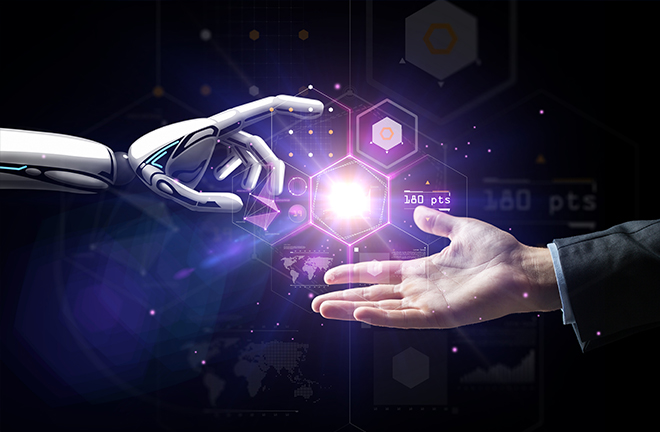Promoting human-machine collaborative creative writing

Human-machine collaboration may facilitate common development. Photo: TUCHONG
In the context of multicultural interactions, the field of intercultural communication has emerged as a necessary platform for intercivilizational exchanges, serving as a key mechanism for dialogue among civilizations and an element for reforming the global governance system.
“Creative writing” is not only an indispensable production method within the cultural and creative industrial chains, but also a primary means of intercultural communication. With the development of artificial intelligence (AI), especially the rapid evolution of multimodal artificial general intelligence language models such as ChatGPT, human-machine collaborative creative writing has become a key enabler of intercultural communication rooted in China’s fine traditional culture. This evolution has ushered in new modalities of communication while presenting a series of opportunities and challenges.
Multimodality
In the era of intelligent media, the new media ecosystem is gradually shifting from traditional “human-to-human” interactions to “human-to-machine-to-human” interactions. Within the tides of technological advancements, self-adaptive shifts in content concepts and paradigms, and algorithmic innovations are accelerating the evolution and convergence of the intercultural communication ecosystem.
Human-machine collaborative creative writing has emerged as the preferred choice in the intelligent media era for intercultural communication. It has demonstrated significant capabilities in achieving scalable effects within the intercultural communication domain and in reaching multiple cultural layers. However, AI-generated creative writing often exhibits a noticeable digital formulaic nature, lacking emotional warmth and cultural depth. Moreover, technical issues such as digital hallucinations challenge the aesthetic acceptance and degree of identification among audiences for the disseminated content. These limitations underscore the necessity for human creators in the process and signal the advent of new formats within the field of intercultural communication.
New modality
In the dynamic field of intercultural communication, the interactive relationship between AI and human creative writers is redefined as a “synergistic partnership” based on complementary advantages. The practice of intercultural creative writing requires open access to knowledge and resources, as well as the extensive incorporation and integration of elements from diverse cultural backgrounds to enrich the material and perspectives of intercultural narratives and stimulate creative thinking. In this process, AI assumes the role of a partner. Therefore, placing AI between decision-making and action can effectively help human authors identify cognitive differences and incommensurable symbols that may exist in intercultural communication. This enhances intercultural understanding and promotes the expansion of cultural empathy in their works. Meanwhile, human creators can leverage academic knowledge and embodied practical experiences to accumulate and build a diverse and profound intercultural knowledge system. This system endows human creators with the ability to make comprehensive decisions through rational and emotional judgments based on knowledge, emotions, and values.
The different roles and creative generation methods of human-machine collaboration in creative writing have given rise to a new modality of human-machine collaborative creative writing, namely “human-machine collaborative intercultural research, algorithmic instruction-guided random narrative + leapfrog cognitive integration, multimodal output and feedback adjustment of intercultural communication products.”
Challenges and opportunities
Human-machine collaborative creative writing in intercultural communication fields presents great potential, but also faces a series of challenges. The widening “digital divide” exacerbates inequalities among different groups in intercultural human-machine collaborative creative expression. However, this trend also provides opportunities for mass production and global consumption of local cultural symbols.
In addition, AI and large language models from different regions and cultures may propagate discrimination in relation to gender, race, social stratification, culture, and other factors due to training data quality and information pollution problems, leading to systematic biases and misleading human creators. To address these challenges, appropriate technology governance measures need to be taken, a technology governance community needs to be formed, the human-centered value orientation needs to be strengthened, and relevant laws and regulations need to be updated continuously to encourage interdisciplinary cooperation and study solutions for the full-process technical regulation and enhancement of intercultural human-machine collaborative creative writing. Meanwhile, enhancing the literacy of human creators in human-machine collaborative creative writing, integrating mechanisms to promote reflective thinking, and developing proactive intercultural human-machine collaborative creative writing systems are essential to maximize efficacy of such systems.
Jiang Yingying is a lecturer from the School of Foreign Languages at Fujian Business University.
Edited by ZHAO YUAN
